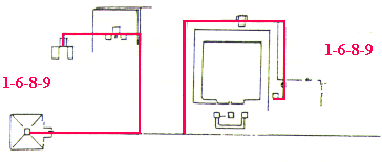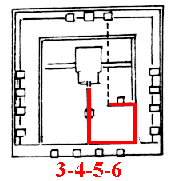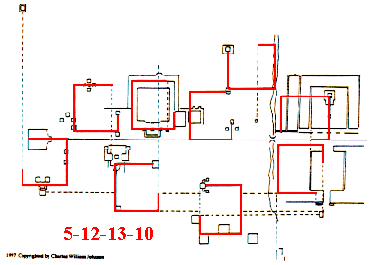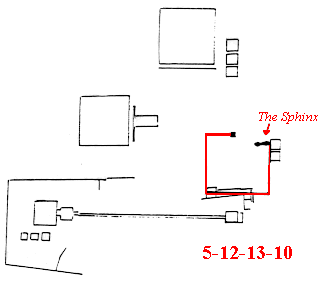SCIENCE IN ANCIENT ARTWORK
Extract No.11
By
Charles William Johnson
The numbers of the perfect right triangle in two distinctive variations (3•4•5 and 5•12•13) appear to have served as a basis for some of the designs in ancient artwork. Other authors have noted the relationship of the 3•4•5 perfect right triangle, but we have possibly not suspected the close relationship shared by the 5•12•13 perfect right triangles present in the sites of Giza and Teotihuacan. Previous discussions in this series have shown how the numbers of the perfect right triangles, alongwith numbers concerning relations of equivalency to the power of three, may be graphed and then identify the layout of the pyramidal sites mentioned. Let us offer only a few examples of this before we discuss the relevance of the 5•12•13 numbers to the cube.
|
|||||
Many distinct variations of the basic designs exist, and these graphs may be related to their numbers to the cube. It is significant to note that some of the relations of equivalency, such as 1³+6³+8³ = 9³ (729 = 729) also reflect the day/year/cycle counts of the ancient reckoning system. The most obvious are in the numbers 216 and 512 correspondingly to the 6 and 8 integers of the relation. However, the series 5•12•13 does not reflect an apparent relation of equivalency, yet the numbers to the cube are significant, since their sum reveals a number series that also relates to the ancient reckoning system: 5³ + 12³ + 13³ = 4050 or 125 + 1728 + 2197 = 4050. The initial observation concerns the doubling/halving of 4050: 4050, 8100, 16200, 32400, 64800, 129600, followed by the Platonic Year 25920. In other words, the sum of the natural number to the cube series pertaining to the 5•12•13 perfect right triangle yields the duplatio/mediatio series relating to the year-count of the precession.
Now, consider the relationship with the previous series of the 1•6•8•9 relation of equivalency. The sum of 729 when doubled/halved yields: 729, 1458, 2916, 5832, 11664, 23328..., etc. The difference between the relational step 23328 and 25920 is 2592; again the fractal referring to the Platonic Year. In other words, in a natural manner the historically significant numbers relating to the precession, such as the Platonic numbers or the Great Year, derive in a natural fashion from the numbers of the perfect right triangles. In ancient kemi it is well known that 1296000 was historically significant.
The fact that the 5•12•13 numbers relate to the layout of the elements and structures at Giza and, the fact that these particular numbers to the cube as computated, refer to the numbers of the precession, would appear to be of great significance once again for considering the basis of science (math) within the ancient artwork. The relationship between the numbers of the ancient reckoning systems around the world and the architectural designs and the designs in the sculptures, somehow defies the concept of mere coincidences. Each time we find a specific relationship between the numbers and the artwork, we obtain the idea of a conscious design, and not the presence of happenstance; which would suggest that all of these coincidences simply mean that the ancient reckoners happened to have made the right mistakes. They just happened to have chosen numbers that relate to natural series of numbers, which in turn happen to be the ones related to astronomical events. Furthermore, they just happened to have built thousands of pyramidal structures that relfect the logic of these numbers, never suspecting a direct relationship existed among all of these elements. Somehow, to us, all of this happenstance rings hollow. It would appear to be the case that the ancient reckoners knew what they were doing.
The significance of the 4050 series becomes obvious in relation to other counts. Consider the following cases among many:
| 4050 x 260 = 1053000 | (1053000/2 | = | 526500) | Now, consider the maya companion number |
| 1366560/5265 | = | 259.56 | whereby, the fractal 25,956 is said to have |
been the maya number for the precession. Furthermore, 5265 x 260c = 1368900, whereby we must remember that the numbers 1•3•6•8•9 refer to previously studied basic designs in relations of equivalency; and, 1368900 - 1366560 = 2340 (2340, 4680, 9360, 18720; the fractal for the maya long count 1872000).
| 4050 x 360c = 145800/2 = | (145800, 72900; the numbers of the 1•6•8 series) |
| 4050 x 365c = 1478250/2 = | (739125, 369562.5, 184781.25, 92390.625, 46195.3125, 23097.5625, 11548.82813, 5774.414063, 2887.207031, 1443.603516, 721.8017578, 360.9008789...) |
| 4050 x 584c = 2365200/2 = | (1182600, 591300, 295650, 147825, 73912.5, 36956.25, 18478.125, 9239.0625, 4619.53125, 2309.765625, 1154.882813, 577.4414063, 288.7207031, 144.3603516, 72.18017578, 36.09008789....) |
In one sweep, we see how the Earth count (365c) relates to the maya count (360c) and the Venus count (584c) relates to those two counts. And, if we divide the Venus number 2365200 by five:
| 2365200/5 = 473040, 94608, 18921.6, 3784.32, 756.864, then we obtain interesting |
Innumerable ways exist for conceiving the 5•12•13 numbers. Even 5 x 12 x 13 = 780 becomes relevant, a Mars count among the ancient maya (3 x 260c = 780). Even the square of the 5•12•13 numbers reflects the historically significant 52c of the ancient Mesoamerican peoples: 5² + 12² + 13² = 338 (338, 676, 1352, 2704, whereby 2704 is 52².
The relationships among the historically significant numbers appear to be endless, just as one would imagine a mathematical computational system to perform. Consider the strangeness of the following computation, which is common to the maya companion numbers in relation to the numbers of the basic designs:
| 729 x 46656 = 34012224/2 = 17006112, 8503056, 4251528, | 2125764, 1062882 |
| - 1366560 | |
| 303678 |
Now, halve 303678, 151839, which is one less than another maya historically significant number: 151840.
And, what about the Nineveh number, 1959552 (fractal); it is obviously related since 756 x 2592 = 1959552: 1959552/ 4050 = 483.83, 241.92, 120.96, 60.48, 30.24, 15.12, 7.56..., etc.
From these few examples, there should be no doubt that the numbers relating to the perfect right triangles, based on the series that begin with 3•4•5 and 5•12•13 relate easily to the historically significant numbers of the ancient reckoning system when considered from the cube of these numbers and in the form of right-angles graphed designs. These basic designs obtained from graphing the corresponding numbers of the perfect right triangles produce figures that reveal a direct relationship to the layout of the pyramidal structures at different sites around the world; especially at the sites of Giza and Teotihuacan. Consider two additional examples:
|
From this relationship, it would not be difficult to consider how the ancients may have walked along the lines, thereby passing specific day-counts, year-counts or cycle-counts as reflected in the numbers. Between and among the different structures, there would be a symbolization represented that would reflect a particular count. The layout of the structures follow, as far as we have been able to see, in almost every case one of the basic designs based on the numbers of the perfect right triangles, not only pertaining to the 3•4•5 perfect right triangle, but to the less common 5•12•13 perfect right triangle series of numbers. In fact, the side measurements of such a triangle, when multiplied by 4, would reflect the integers 20³ + 48³ + 52³, and reveal the sum of 259200, or ten Platonic Years (ten precessional cycles). These three integers reveal three historically significant number series employed in the ancient reckoning systems of Mesoamerica without a doubt: 20, 40, 80, 160, 320, 640, 1280, 2560, 5120, 10240...; 48, 96, 192, 384, 768, 1536, 3072, 6144, 12288, 24576...; and 52, 104, 208, 416, 832, 1664, 3328, 6656, 13312, 26624....
The numbers of the perfect right triangles form natural divisions among the number counts and series. The historically significant numbers relate and perform in accordance with the natural number series coming out of the numbers corresponding to the different perfect right triangles, and when taken to distinct powers, it would appear that the historically significant numbers were chosen precisely upon such a basis of reasoning. But, what is even more intriguing is the fact that the events in nature, the astronomical events such as the precession of the equinoxes (alongwith other events at distinct levels of nature, such as the behaviour of electrons in the atom) also appear to reflect the different numbers and number series coming out such relationships of equivalency.
Your comments and suggestions are greatly appreciated:
e-mail: johnson@earthmatrix.com
Science in Ancient Artwork
Giza and Teotihuacan:5•12•13
Extract N°.11
July 1997
©1997-2015 Copyrighted by Charles William Johnson. All Rights Reserved
Earth/matriX,
Reproduction prohibited without written consent of the author.
| Home | Forum | Reviews | Links | Author |





